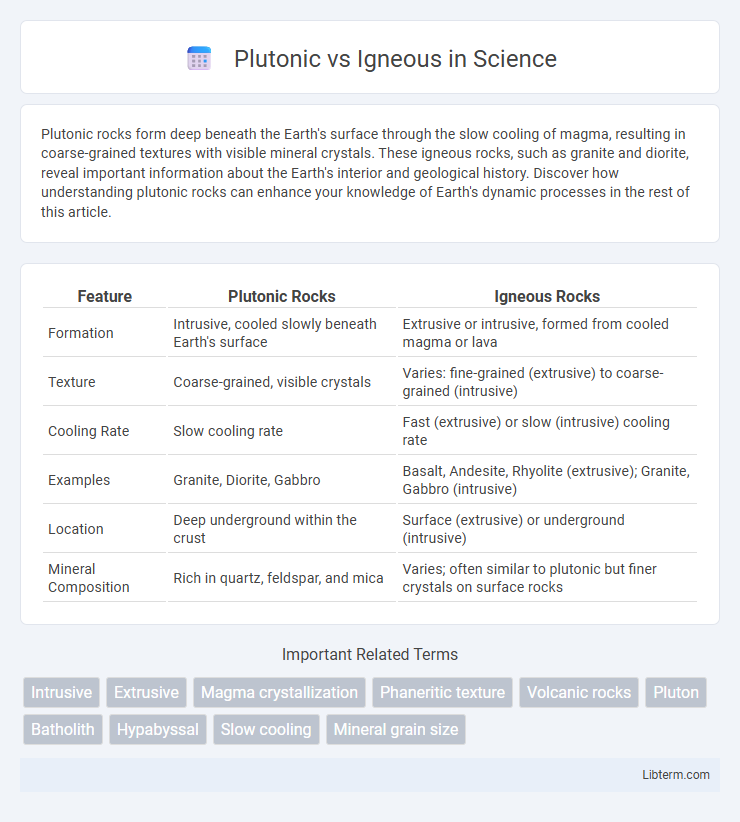Plutonic rocks form deep beneath the Earth's surface through the slow cooling of magma, resulting in coarse-grained textures with visible mineral crystals. These igneous rocks, such as granite and diorite, reveal important information about the Earth's interior and geological history. Discover how understanding plutonic rocks can enhance your knowledge of Earth's dynamic processes in the rest of this article.
Table of Comparison
| Feature | Plutonic Rocks | Igneous Rocks |
|---|---|---|
| Formation | Intrusive, cooled slowly beneath Earth's surface | Extrusive or intrusive, formed from cooled magma or lava |
| Texture | Coarse-grained, visible crystals | Varies: fine-grained (extrusive) to coarse-grained (intrusive) |
| Cooling Rate | Slow cooling rate | Fast (extrusive) or slow (intrusive) cooling rate |
| Examples | Granite, Diorite, Gabbro | Basalt, Andesite, Rhyolite (extrusive); Granite, Gabbro (intrusive) |
| Location | Deep underground within the crust | Surface (extrusive) or underground (intrusive) |
| Mineral Composition | Rich in quartz, feldspar, and mica | Varies; often similar to plutonic but finer crystals on surface rocks |
Introduction to Plutonic and Igneous Rocks
Plutonic rocks are a type of igneous rock that form deep beneath the Earth's surface through the slow cooling and solidification of magma, resulting in coarse-grained textures such as granite and diorite. Igneous rocks broadly include both plutonic (intrusive) and volcanic (extrusive) rocks, classified by their formation location and cooling rates. Understanding the mineral composition and crystalline structure of plutonic versus volcanic igneous rocks is essential for interpreting Earth's geological processes and crustal evolution.
Defining Plutonic Rocks
Plutonic rocks are a type of igneous rock that forms from the slow cooling and solidification of magma beneath the Earth's surface, resulting in coarse-grained textures with large, visible crystals. Unlike volcanic igneous rocks, which cool rapidly at or near the surface, plutonic rocks such as granite and diorite exhibit a more uniform and well-developed crystalline structure. These intrusive formations provide critical insights into the composition and thermal history of the Earth's crust.
Overview of Igneous Rocks
Igneous rocks form through the solidification of magma or lava and are categorized into plutonic (intrusive) and volcanic (extrusive) types based on their formation environment. Plutonic igneous rocks, such as granite, crystallize slowly beneath the Earth's surface, resulting in coarse-grained textures. In contrast, volcanic igneous rocks, like basalt, cool rapidly at or near the surface, producing fine-grained or glassy textures.
Formation Processes: Plutonic vs Igneous
Plutonic rocks are a subtype of igneous rocks that form from the slow cooling and solidification of magma beneath the Earth's surface, resulting in coarse-grained textures. In contrast, igneous rocks include both plutonic (intrusive) and volcanic (extrusive) types, with volcanic rocks forming from the rapid cooling of lava at or near the surface, producing fine-grained or glassy textures. The key distinction lies in the cooling rate and environment, which directly influence crystal size and rock texture in plutonic versus volcanic igneous formations.
Texture and Grain Size Differences
Plutonic rocks, a subset of igneous rocks, are characterized by coarse-grained textures due to slow cooling of magma beneath the Earth's surface, allowing large crystals to form. In contrast, igneous rocks that cool rapidly on the surface, like volcanic rocks, exhibit fine-grained or aphanitic textures with small, often microscopic crystals. The distinct grain size and texture differences between plutonic and volcanic igneous rocks provide key insights into their cooling histories and formation environments.
Common Minerals in Plutonic and Igneous Rocks
Plutonic rocks, a subtype of igneous rocks, commonly contain minerals such as quartz, feldspar (both orthoclase and plagioclase), and mica, which form through slow cooling beneath the Earth's surface. Igneous rocks, in general, include a broader range of minerals like olivine, pyroxene, amphibole, as well as the feldspars and quartz present in plutonic varieties, reflecting their diverse formation environments from intrusive to extrusive. The mineral composition in both plutonic and other igneous rocks is critical for determining their classification, texture, and color index, aiding geologists in understanding their formation history and tectonic setting.
Major Examples of Plutonic Rocks
Major examples of plutonic rocks include granite, diorite, gabbro, and syenite, all formed through the slow cooling and solidification of magma beneath the Earth's surface. These coarse-grained textures distinguish plutonic rocks from volcanic igneous rocks like basalt and andesite, which cool rapidly on the surface. The mineral composition of plutonic rocks, rich in quartz, feldspar, and mica, reflects their intrusive origin and crystallization depth.
Volcanic (Extrusive) vs Plutonic (Intrusive) Rocks
Volcanic (extrusive) rocks form from magma that cools rapidly on the Earth's surface, resulting in fine-grained or glassy textures, like basalt and rhyolite. Plutonic (intrusive) rocks crystallize slowly beneath the surface, creating coarse-grained textures exemplified by granite and gabbro. The cooling rate and environment control mineral size and rock characteristics, distinguishing extrusive volcanic rocks from intrusive plutonic rocks.
Geological Importance and Uses
Plutonic rocks, formed from slow-cooling magma deep beneath the Earth's surface, exhibit coarse-grained textures vital for understanding subsurface geological processes and Earth's crust composition. Igneous rocks, encompassing both plutonic and volcanic varieties, play a crucial role in reconstructing tectonic settings and mineral exploration due to their diverse mineral assemblages. Their widespread use in construction, dimension stone, and as sources of valuable minerals underscores their economic and geological significance.
Key Differences Summarized
Plutonic rocks are a category of igneous rocks that crystallize slowly beneath the Earth's surface, resulting in coarse-grained textures, whereas other igneous rocks can form either beneath the surface or from lava cooling quickly on the surface, often leading to fine-grained or glassy textures. The primary distinction lies in the cooling rate and environment: plutonic rocks cool slowly intrusively, while volcanic igneous rocks cool rapidly extrusively. Examples of plutonic rocks include granite and diorite, while basalt and rhyolite represent volcanic igneous rocks.
Plutonic Infographic

 libterm.com
libterm.com